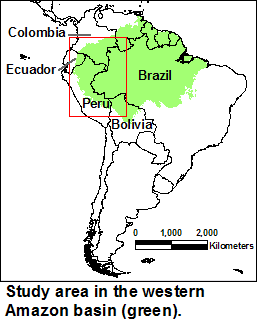Texaco’s impact on
the el Oriente region of the Amazon
rainforest
Our world’s
never ending thirst for oil and gas has motivated many companies to explore
increasingly remote places to find these lucrative resources. This profit
driven and unsustainable part of our economy has caused catastrophic results
for both environments and communities. Sadly, the Amazon rainforest has become
a victim of human greed as the oil and gas industry has caused extensive
damages such as deforestation, indigenous conflict, biodiversity loss and,
soil, aquatic and air pollution. Most of the Amazon’s oil industry is
concentrated in the rainforest’s western part (figure 1) where there is now more than 180 oil and gas
blocks covering 688’000km2 of forest controlled by around 35 oil
multinationals. This poses a huge threat as the western Amazon is the most biologically rich part of the Amazon rainforest.
Many
Amazonian regions have already been deeply impacted by the oil industry.
Perhaps one of the most dramatic example of this is seen in Ecuador’s El Oriente region which has been
significantly destroyed by oil extraction.

Ecuador’s economy is heavily reliant on
the exportation of crude oil which accounts for 49.6 percent of the country’s total exports. This poses a
serious environmental concern as 99 percent of the country’s oil is found in
the Ecuadorian Amazon. A large part of
that oil is present in a 130’000 square kilometres area called el Oriente. This area is known for its
diverse rainforest and plays a vital part in the catchment basin that feeds the
Amazon river network.
Unfortunately,
the area has been under a tremendous amount of environmental and social stress ever
since 1967, when Texaco discovered large oil reserves and starting extracting
it.
Each stage
of the industrial production of oil in el
Oriente dramatically damages the environment. The exploration stage which involves
the detonation of tons of dynamite to map out the natural petroleum reservoirs
leads to substantial deforestation. The drilling stage is responsible for 4’000 cubic meters of toxic waste per well
which includes: excess oil, heavy metals, salts and more. This waste is then deposited into poorly
constructed open waste pits (up to 80% of all pits) which renders the waste
vulnerable to leaching out and overflowing.
This leads to considerable contamination of the soil, surface and sub
surface water systems. The oil processing itself is responsible for an
additional 4.3 million gallons of untreated toxic waste a
day in 1994 (through the separation of viable oil from waste) which is also
poured into the open waste pits. The thick crude oil residue which forms at the
surface of these wells is then burned causing acid rain throughout the region.
Even the transportation
of petroleum is unsustainable. Indeed, the trans-Andean pipeline which connects
the Pacific ports to the el Oriente
region has been responsible for the leakage of 16.8 million gallons of
petroleum between 1972 and 1990. Most of this has contaminated the headwaters
of the Amazonian river systems.
These
combined effects caused major biodiversity and habitat loss. Indeed, 159 of Ecuador’s endemic species are now
threatened. The soil next to the extraction points have become so toxic that
nothing can grow on it anymore and many sources of natural drinking water have
been poisoned.
El Oriente’s oil business has also affected indigenous tribes
such as the Huaorani tribe who call this part of the forest their homeland. Through
the expansion of the oil industry these people have been forced into smaller
and smaller areas. Indeed, in 2012 the Huaorani have about 6’800 square
kilometres of land which is only a third of their original territory. Not only
has their territory been massively reduced, 100s of them were also dislocated in the 1960s when Texaco asked the Ecuadorian
government for permission to drill oil on Huaorani land. For many, their lives
and culture has changed for ever as contact from the outside world has changed
their food source and has even introduced drugs into their lives! Additionally,
their constant exposure to leaked crude oil and its constituents (through
contaminated water for instance) has been causing symptoms ranging from a
headaches to cancers (Harvard report). In sum, the indigenous
people of Ecuador have been victims of clear human rights violations.
In
conclusion, the oil industry has directly affected both the environment and
local populations in the el Oriente’s
region of Ecuador. Many indirect events have also fuelled the problem. For
instance, money generated by the oil business has allowed the
government to build roads and subsidise cattle ranching and
agriculture which
caused further environmental degradation. Unfortunately, regulations and
judicial remedies and information are still grossly inadequate. Consequently, unless
a major reform takes place, Ecuador’s government as well as multinational
companies will continue to harm thousands of its citizens and destroy their
country’s fragile wilderness.
No comments:
Post a Comment